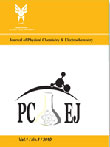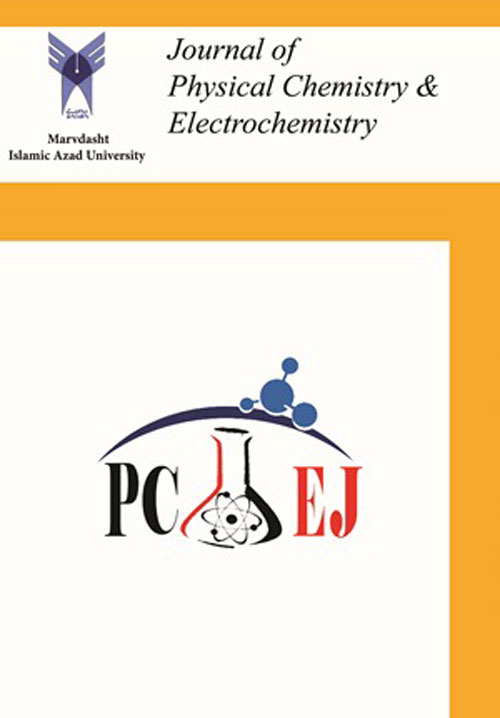فهرست مطالب

Journal of Physical Chemistry & Electrochemistry
Volume:1 Issue: 4, 2012
- تاریخ انتشار: 1391/09/28
- تعداد عناوین: 6
-
Pages 171-177A method for predicting liquid densities of binary mixtures from heat of vaporization and liquid density at boiling point temperature (ΔHvap and n b ρ) as scaling constants, is presented. B2(T) follows a promising corresponding-states principle. Calculation of α(T) and b(T), the two other temperature-dependent constants of the equation of state, are made possible by scaling. As a result ΔHvap and n b ρ are sufficient for determination of thermophysical properties of liquid mixtures. We applied the procedure to predict liquid densities of (x1 n-butane + x2 isobutane) at compressed state with temperature range from 280 to 440 K and pressures up to 200 MPa. The experimental liquid densities were correlated satisfactory with our procedure and the results are within 5%.Keywords: Equation of State, Liquid Densities, Scaling Constants
-
Pages 179-183On the basis of experimental data a kinetic model for the heterogeneous interaction between alkylperoxy radicals and organic compounds in Langmuir- Hinshelwood approach at room temperature has been offered. The effect of oxygen on the kinetics of process in the presence, [O2]o = 1 x 1011 – 1.6 x 1012 molecules.cm- 2, and absence of oxygen has been analyzed. Over time the chain degenerate branching mechanism of the process is accompanied by the increase of the radicals concentration in the presence of oxygen. However, in the absence of oxygen the radicals are consumed continuously and the length of chains becomes shorter. In this situation the phenomenon of radicals multiplication does not take place attributed to decrease the chain consumption rate of organic compound reagent.Keywords: Kinetics Model, Mechanism, Alkylperoxy Radical, Organic Compound, Rate Constant
-
Pages 185-190Nano-ZnO was employed for the adsorption of 4C2NP from aqueous solutions in batch equilibrium experiments to investigate its adsorption properties. The quantity of 4C2NP adsorbed onto nano- ZnO surface was measured by UV-Vis spectrophotometer. The effects of contact time, adsorbent dose, pH, and initial concentration of 4C2NP were investigated. The adsorption found to be strongly influenced by all the above parameters. The optimized conditions for maximum amount of adsorption were also determined. The results showed that adsorption of 4C2NP by nano-ZnO reached to equilibrium after 60 minutes and maximum 4C2NP removal (46.5 %) was observed at pH =6. Also, removal efficiency of 4C2NP decreased by increasing the initial concentration. Experimental data were analyzed by Langmuir and Freundlich isotherms. Experimental results indicated that the equilibrium adsorption data fitted well in the Freundlich isotherm equation with a correlation coefficient equal to 0.995.Keywords: Nano, ZnO, 4, Chloro, 2, nitrophenol, Isotherm, Adsorption, Catalyst
-
Pages 191-196A PVC membrane electrode based on 1-[({[(butylsulfunyl)carbothioyl]disulfanyl} carbothioyl)sulfanyl] butane as a suitable ion carrier for determination of lanthanum(III) ion was prepared. This electrode revealed such a good selectivity toward La3+ ion over a wide variety of other metal ions. Some experimental parameter such as membrane composition, nature, and amount of plasticizer, the amount of additive, and concentration of internal solution on the potential response of La3+ sensor were investigated. The electrode exhibits a Nernstian slope of 20.9±1.8 mV per decade of La3+ over a wide concentration range 3.3×10-7-1.0×10-2 M in the pH range 3.7-7.3. The response time is about 7s and detection limit is 2.5 ×10-7 M and it can be used for at least 1month without any considerable divergence in potential. It was used as an indicator electrode in potentiometric titration of lanthanum(III) ion with EDTA.Keywords: Lanthanum (III), Ion Selective Electrode, PVC
-
Pages 197-2012-Amino-substituted ketones react with α-methylene ketones under solvent-free conditions at 90 °C in the presence of a catalytic amount of zirconium dodecylphosphonate to create the corresponding quinolines in excellent yields. This procedure recommends numerous advantages such as easy work-up, use of mild, reusable and safe catalyst, short reaction timeand high yields. The new compounds have been characterized by 1H-NMR, 13C-NMR, mass and elemental analysis data.Keywords: Zirconium dodecylphosphonate, Quinolines, Solvent, free, Reusable catalyst
-
Pages 207-211The electrochemical oxidation of methyl catechol in the presence of 2-thiouracil (as a nucleophile) has been performed in aqueous solutions using cyclic voltammetry and controlled-potential coulometric techniques. The electrochemical behavior of methyl catechol in the presence of 2-thiouracil was investigated. The electrochemical synthesis of this compound has been successfully performed in an undivided cell in a good yield and purity and was characterized by IR, 1H and 13C NMR. According to the results obtained from 1H NMR, 13C NMR it is concluded that methyl o-quinones are attached in all probably only in the its C4 position to 2-thiouracil from S position leading to the formation of 2-(4,5-dihydroxy-2-methylphenylthio) pyrimidin-4(3H)-one (DMPTP).Keywords: Methyl catechol, 2, Thiouracil, Electro, organic synthesis


